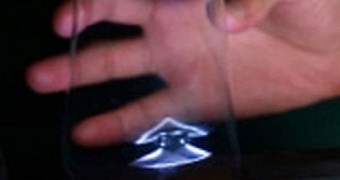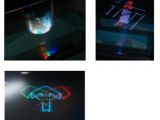Normally, displays are made of some sort of glass substrate with a sheet or frame of LEDs and liquid crystals for color, or maybe organic light emitting diodes (OLED). Omron decided to totally ignore regular conventions and use plastic though.
The new 3D display technology is called "Transparent Plate-type Space Projection Technology," or TPSPT for short, although some may feel it's more of a mouthful to use the abbreviation than the actual name.
Contrary to the regular 3D technologies out there, the newcomer isn't intended for TVs and monitors.
Indeed, the Omron 3D panel is supposed to be well suited to augmented reality devices (like Google Glass) and virtual reality, or VR for short (like Oculus Rift and its derivatives).
Signboards, public facility guide signs and the visualization of sensitive areas in space (through gesture-controlled devices and non-contact switches) are also pegged as possible applications.
The Omron Transparent Plate-type Space Projection Technology
In essence, a three-dimensional image is projected in space by emitting light from a transparent plate or sheet of plastic. LED lamps and light guide plates and LCD displays can be used as the light source.
The light-emitting sheet is thin, light and pretty much invisible, and can be attached to glass if you feel that plastic alone won't cut it. It is this that makes it a good fit for digital signage technologies. The sheet can either be left flat or bent to suit whatever window/surface you are attaching it to.
Unfortunately, for now, only still images can be projected this way, which explains why Omron doesn't see TVs, monitors and other such things in its invention's future. At least not its near future.
It is possible to stack multiple sheets, allowing you to switch images easily, or even display color and animation, basically circumventing the whole “only still images are supported” limitation somewhat. That an image can be projected on both sides of a sheet helps.
And since no special lenses and projection equipment is required, the Omron approach can be implemented for a lot less money than anything else used to create 3D images.
What it all means
Omron set out to create a display technology that doesn't use regular flat panel TV design elements at all, and it has succeeded.
The technique works on both concave and convex surfaces by the way, although it might affect how the 3D image turns out. Either way, it will seem like you're looking at a hologram, more or less.

 14 DAY TRIAL //
14 DAY TRIAL // 

